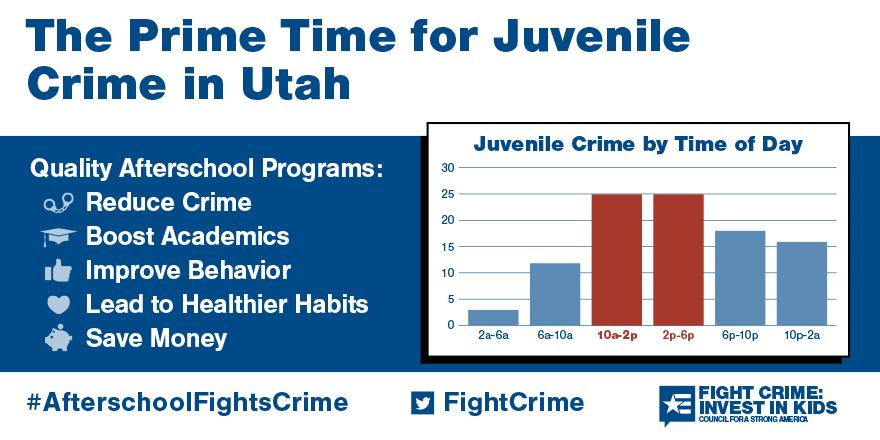After School: Still the Prime Time for Juvenile Crime in Utah
Afterschool Fights Crime in Utah
Related
The more than 5,000 law enforcement leaders around the nation who are members of Fight Crime: Invest in Kids, have long known that the hours immediately after school lets out, when parents are likely not available to supervise, are the prime-time for juvenile crime. Over the past 20 years, law enforcement leaders across the country have relied on high-quality afterschool programs to provide supportive, stable, and enriching environments with caring adults that keep children and youth out of trouble and safe, while supporting their academic success, and social and emotional development.
The Prime Time for Juvenile Crime in Utah

In Utah, juvenile crime peaks from 10 a.m. to 2 p.m. and from 2 to 6 p.m. on school days, with about 25 percent of all juvenile crime on those days occuring during the hours following the last school bell.
The crime peaks not occurring from 2 to 6 p.m. are largely due to much of law enforcement in those states recording youth criminal activity as having all occurred at only one hour during the day, often noon or midnight. This would artificially inflate the crime rate for that time period.
Program Highlight: Promise South Salt Lake
Promise South Salt Lake began in 2012 as a citywide initiative to better the entire South Salt Lake community by approaching issues with holistic, community-based solutions that considered all aspects of the lives of young people and their families. Spearheaded by Mayor Cherie Wood, Promise South Salt Lake operates 14 neighborhood centers in partnership with numerous stakeholders including the South Salt Lake Recreation Department, Police Department, Community Development Department, Urban Livability Department, and United Way. The neighborhood centers carry out Promise South Salt Lake’s mission to create a positive community environment that meets their three guiding goals around the education, safety, and health of their residents. One of the main features of these neighborhood centers is afterschool programming, which began in 2007, but was formally incorporated into the city-based initiative in 2012.
I believe that providing safe places and enlisting caring adults who address our youths’ academic needs, social and civic development, and physical fitness through quality afterschool programs have made a big difference in their lives and in the overall climate of their community.
Fight Crime: Invest in Kids former member Chris Snyder, former South Salt Lake Chief of Police
From athletics programs, such as boxing offered in collaboration with the South Salt Lake Police Athletic/Activities League, to arts and technical programs such as woodshop, cooking, and hula dance, the neighborhood centers offer a variety of afterschool programming options that create spaces to engage youth in learning and keep them safe afterschool. According to the 2014 Promise South Salt Lake afterschool program report, between 2011 and 2013, there was a 50 percent increase in the number of surveyed 3rd-6th grade program participants indicating, “I am confident I can use strategies to get out of peer pressure” with regards to smoking, drinking, and marijuana use. Surveyed school day teachers also noted that 69% of afterschool program participants improved or greatly improved their classroom behavior as a result of afterschool program participation. Based on a 2015 analysis, the risk of gang involvement for South Salt Lake’s eighth graders dropped from 25.6 percent to 7.2 percent since the time that South Salt Lake afterschool programming began in 2007, and the city’s overall juvenile crime rates between 3pm and 6pm dropped 64 percent during that same timeframe. Chris Snyder, former Chief of Police of South Salt Lake, agrees about the positive impact of afterschool programs saying, “I believe that providing safe places and enlisting caring adults who address South Salt Lake youths’ academic needs, social and civic development, and physical fitness/healthy lifestyles issues through quality afterschool programs have made a big difference in the lives of our city’s youth and in the overall climate of our community.”
Download the Graphic
Read More About
States
